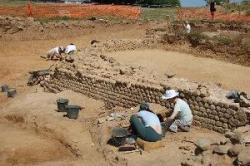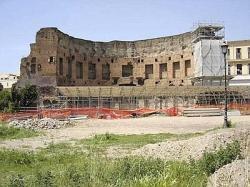- 12 JUILLET
- INDI-UNI : 
PRE-INSCRIPTION : 15 Juin – 15 Août
PRE-REGISTRATION: June 15th - August 15th
- CHINE – Handan - Archaeologists in north China's Hebei Province said that the skeletons found under the ruins of a 4,000-year-old well may belong to slaves sacrificed after the death of their masters. Five layers of human skeletons were found under the ruins of the ancient well, with some of them show signs of struggle before death, said Qiao Dengyun, head of the cultural relics protection bureau in the city of Handan, where the relics were discovered. "It seems that some even had their head chopped off," Qiao said. Archaeologists believe the remains belong to slaves who were killed or buried alive with their dead masters, which, according to historical records, was practiced in China thousands of years ago.
http://www.kaogu.cn/en/detail.asp?ProductID=2930
- CHINE – Poliu - According to the Shaanxi Cultural Relic Bureau, archaeologists have found some liquid in a bronze kettle inside a tomb dating from the Qin Dynasty in Poliu Village of Xianyang, Shaanxi province. The liquid has been sent to a research institute for further study. Xie Gaowen, a research associate at Xianyang Archaeological Institute, said that the bronze kettle is believed to have been a wine vessel in the ancient times. Archaeologists speculated that there was a cork on the kettle but it had carbonized and disappeared. The liquid did not volatilize because the kettle was sealed by soil. It would not be the first time that archaeologists have found wine in the tombs in central Shaanxi region. From March to June in 2003, archaeologists found three large tombs and 17 large bronze kettles. Two of them stored 26 kilograms of green, clear liquid. Experts said the liquid contained alcohol and it was the best-preserved wine found that dates back 2, 000 years ago. On Oct.30, 2009, villagers in Mei County dug up some pots containing liquid, which was later authenticated as wine by the Biology Institute of Chinese Academy of Science in Chengdu. The wine is 200 years older than the wine found in March 2003 in Xi'an. At the end of 2010, Shaanxi Archaeological Institute found some "suspected wine," which was 2,400 years old and sealed in a bronze kettle. Xie Gaowen said more works need to be done to decide whether the mysterious liquid is wine from the Warring States Period
http://www.kaogu.cn/en/detail.asp?ProductID=2929
- FRANCE –  Tintignac – A Naves, le sanctuaire gaulois de Tintignac dévoile un peu plus ses mystères. «Il serait intéressant de fouiller les arènes de Tintignac et le travail serait facile et peu coûteux ». Lorsque Prosper Mérimé a prononcé cette phrase, il ne se doutait sûrement pas que l'étendue réelle du site gallo-romain, datant du IIIe avant Jésus-Christ, est estimée à ce jour à plus de 70 hectares. Les archéologues se trouvent de nouveau sur le site archéologique pour déceler les trésors enfouis sous terre. Un travail de longue haleine en perspective puisqu'il faut passer chaque centimètre au peigne fin. Le chantier, qui nécessite à la fois le travail de gros engins et de petites mains ouvrières, devra être terminé en 2014, en même temps que l'aire d'autoroute qui donnera un accès direct au site. Depuis 2009, c'est vers le système de circulation qu'archéologues et bénévoles se sont tournés. « Nous avons de bonnes surprises car les voies entre les différents monuments sont très bien conservées, » souligne Christophe Maniquet, archéologue à l'Institut national de recherches archéologiques (INRAP). Actuellement une quinzaine de bénévoles se trouvent sur le site. « Il s'agit d'une fouille programmée qui se fait avec le minimum de moyens ». C'est surtout le tribunal qui requiert leur attention. Vraisemblablement détruit par un incendie, comme en témoigne le niveau noirâtre et charbonneux devant l'édifice, il s'étend sur 75 mètres de longueur. Pour l'instant aucun élément ne permet de savoir si cet incendie est d'origine criminel ou accidentel.
Tintignac – A Naves, le sanctuaire gaulois de Tintignac dévoile un peu plus ses mystères. «Il serait intéressant de fouiller les arènes de Tintignac et le travail serait facile et peu coûteux ». Lorsque Prosper Mérimé a prononcé cette phrase, il ne se doutait sûrement pas que l'étendue réelle du site gallo-romain, datant du IIIe avant Jésus-Christ, est estimée à ce jour à plus de 70 hectares. Les archéologues se trouvent de nouveau sur le site archéologique pour déceler les trésors enfouis sous terre. Un travail de longue haleine en perspective puisqu'il faut passer chaque centimètre au peigne fin. Le chantier, qui nécessite à la fois le travail de gros engins et de petites mains ouvrières, devra être terminé en 2014, en même temps que l'aire d'autoroute qui donnera un accès direct au site. Depuis 2009, c'est vers le système de circulation qu'archéologues et bénévoles se sont tournés. « Nous avons de bonnes surprises car les voies entre les différents monuments sont très bien conservées, » souligne Christophe Maniquet, archéologue à l'Institut national de recherches archéologiques (INRAP). Actuellement une quinzaine de bénévoles se trouvent sur le site. « Il s'agit d'une fouille programmée qui se fait avec le minimum de moyens ». C'est surtout le tribunal qui requiert leur attention. Vraisemblablement détruit par un incendie, comme en témoigne le niveau noirâtre et charbonneux devant l'édifice, il s'étend sur 75 mètres de longueur. Pour l'instant aucun élément ne permet de savoir si cet incendie est d'origine criminel ou accidentel.
http://www.lamontagne.fr/editions_locales/tulle/sur_les_traces_des_vestiges_gallo_romains@CARGNjFdJSsBHh0BBhU-.html
- ITALIE –  Rome - Roman Emperor Nero's first century Domus Aurea villa will be closed to visitors for at least another three years as complicated repairs to the sprawling complex cause its scheduled 2011 reopening to be delayed, said the Italian culture minister's director general for archeology Luigi Malnati. Some historians say Nero started the great fire that charred much of Rome in 64 AD to make room for his 300 acre Domus Aurea, or Golden House that was adorned by gold leaf and dazzling frescos.Following his suicide in 69 AD, the complex was considered a symbol of Nero's arrogance and was buried and built over after the gold, pearls and other valuable jewels laid into its some 150 rooms were stripped. After 18 years of restoration work it was reopened in 1999 but was repeatedly closed because of collapses due to moisture.
Rome - Roman Emperor Nero's first century Domus Aurea villa will be closed to visitors for at least another three years as complicated repairs to the sprawling complex cause its scheduled 2011 reopening to be delayed, said the Italian culture minister's director general for archeology Luigi Malnati. Some historians say Nero started the great fire that charred much of Rome in 64 AD to make room for his 300 acre Domus Aurea, or Golden House that was adorned by gold leaf and dazzling frescos.Following his suicide in 69 AD, the complex was considered a symbol of Nero's arrogance and was buried and built over after the gold, pearls and other valuable jewels laid into its some 150 rooms were stripped. After 18 years of restoration work it was reopened in 1999 but was repeatedly closed because of collapses due to moisture.
http://www.adnkronos.com/IGN/Aki/English/CultureAndMedia/Italy-Neros-Golden-House-to-remain-closed-to-visitors_312218349118.html
- ROYAUME UNI - Whirlow Hall Farm - Evidence of human activity dating back to Roman times has been found at a city farm as part of a volunteer-led archaeology study. Experts believe the survey has unearthed remains of an Iron Age or Romano-British settlement at Whirlow Hall Farm in Sheffield, and the discovery has caused considerable excitement. A rectangular enclosure formed by a ditch was revealed during a geophysical survey. Excavations on the enclosure are due to start later this month, with volunteers carrying out much of the work under the guidance of trained archaeologists. A series of field walks have also been organised as part of the Whirlow Hall project which began in April. Those walks have yielded a collection of more than 1,000 finds including flint tools from the Mesolithic and Early Bronze Age.
http://www.yorkshirepost.co.uk/news/around-yorkshire/local-stories/volunteers_unearth_evidence_of_iron_age_settlement_in_yorkshire_city_1_3567805
- USA – Mitchell - The Mitchell Prehistoric Indian Village’s archaeology team has reported new finds. A bison scapula hoe and a “wonderfully carved” awl made of a fox tibia were recently found. Archaeologists also found a stone drill point and some beads. “These finds show that the people who lived here really were not primitive at all, but a rather sophisticated culture that enjoyed music and pretty things such as jewelry and fine pottery,” said a news release from the Indian Village. “We can learn much from the small items as well as the big items.”
http://www.mitchellrepublic.com/event/article/id/54604/group/homepage/
- FRANCE – Mérignac - La procédure administrative de l'îlot 3 de la ZAC progresse. Toutefois, la phase de construction ne devrait pas démarrer avant le deuxième trimestre 2012. La raison ? Des fouilles archéologiques sont envisagées in situ. « Nous le savions depuis l'origine. Ces fouilles préliminaires figurent dans le cahier des charges de Bordeaux Métropole Aménagement (BMA), l'aménageur global de la ZAC. En 2007, un diagnostic avait révélé l'existence de sépultures médiévales datant probablement du haut Moyen Âge et de traces de sarcophages mérovingiens », détaille Bruno Lees-Mélou. Les recherches se concentreront sur les berges de la Devèze, une rivière aujourd'hui canalisée, au bord de laquelle se dresse l'édifice religieux. Un arrêté préfectoral préconise ce sondage avant toute initiative en sous-sol. Confiée à l'Inrap, l'opération aura lieu au printemps 2012, l'hiver s'avérant une saison peu propice pour les fouilles.
http://www.sudouest.fr/2011/07/09/un-ilot-3-gorge-d-histoire-448268-3001.php
- FRANCE – Narbonne - Les fouilles archéologiques des ports romains de Narbonne reprennent cet été sur le site, après une première campagne très fructueuse en 2010. Rappelons que ces fouilles s'inscrivent dans le cadre d'un partenariat entre CNRS, Région, DRAC, Université Montpellier 3, l'INRAP et Conservatoire du littoral. Jusqu'au 23 septembre, un bassin circulaire, des jetées mais aussi une villa maritime feront l'objet de recherches pluridisciplinaires. Ces travaux permettront de mieux comprendre les interactions entre l'homme et le littoral.
http://www.lindependant.fr/2011/07/09/les-fouilles-reprennent-dans-les-ports-antiques,39680.php